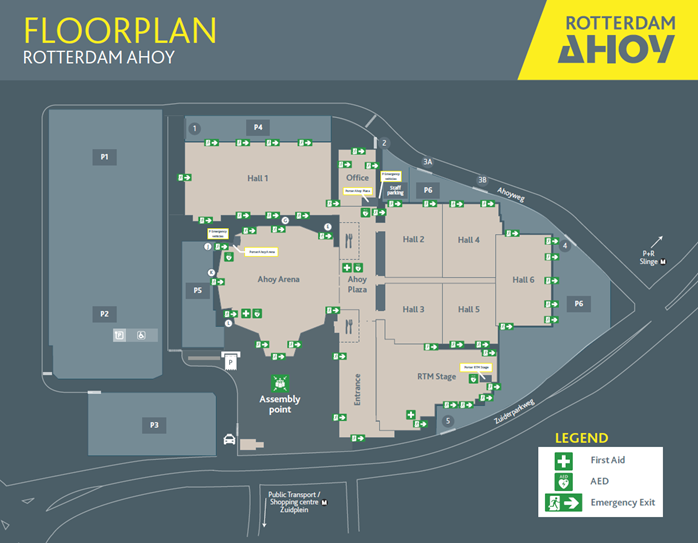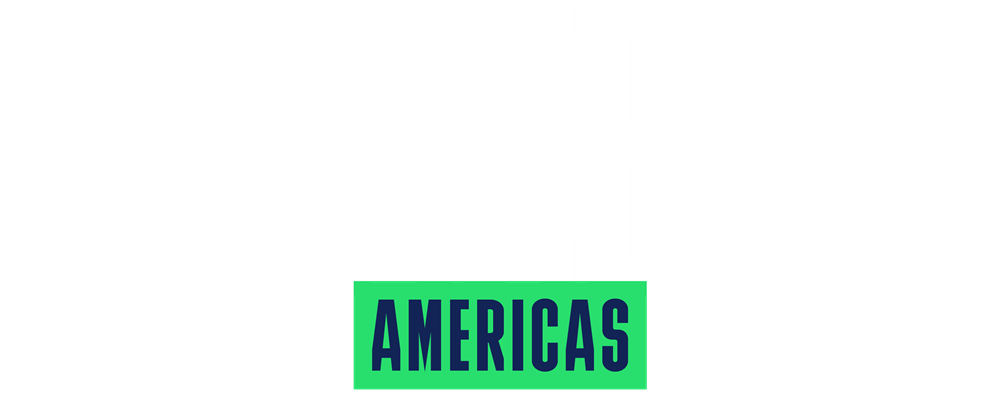This section is designed to give you sufficient guidance. Guidance, however, can only go so far and you have a legal duty to ensure that your teams, contractors and partners follow Health and Safety laws and regulations. Failing to do so can lead to prosecution and other legal sanctions. If you need further assistance or information, do not hesitate to contact Breakbulk Support.
Policy Statement
Breakbulk Events & Media recognises that our exhibitors rely on us to provide a trading environment on the exhibition floor which is safe and without risks to health. We also recognise that running a public event places a special responsibility on Breakbulk Events & Media and extends our duty of care not only to our staff but to exhibitors, contractors, venue staff and visitors. The organiser is ultimately responsible for Health and Safety at the show.
To ensure that all health and safety obligations are met, the organisers will:
-
Allocate sufficient resources to meet Health and Safety objectives. • Provide adequate control of Health and Safety risks arising from work activities.
-
Consult with the venue, exhibitors and contractors on matters affecting health and safety.
-
Provide relevant Health and Safety information to employees and others.
-
Ensure all employees are competent to do their tasks particularly regarding Health and Safety training.
-
Ensure so far as is reasonable that the contractors we engage for the show are competent.
-
To far as is reasonably practicable prevent accidents and cases of work-related ill-health and maintain safe and healthy working conditions.
Accidents
All Accidents and near misses should be formally logged with witness statements and accompanied by video or photographs taken. All reports may be used for future investigation, therefore as much detail should be recorded. All documents are to be treated with the upmost confidentiality and as such should be stored in accordance with data protection laws and regulations. If an incident occurs onsite, please either see a Health and Safety team member or notify staff member in the operations team who will inform Health and Safety team.
Children
Under no circumstances are children under the age of 16 years allowed into the exhibition halls during the build-up, show open days or breakdown.
Drink and drugs
Drinking of alcohol onsite during the build-up and breakdown phase is forbidden. Anyone under the influence of alcohol or forbidden substances will be removed from site immediately. Use of drugs are not permitted anywhere in the venue.
Electrical wiring and installation
Electrical fittings must be installed by the designated Rotterdam venue electrical service provider. Any electrical equipment brought onto the Rotterdam venue premises must comply with the Electrical Installation Regulations and the Electrical Machinery Regulations. A Certificate of Compliance (COC) is to be produced for any electrical connections made to the Rotterdam venue electrical distribution.
Such a certificate can only be issued by a registered electrician. Should this not be the case, equipment will be removed immediately from the premises at the exhibitor’s expense and charges for any damage caused by faulty equipment will apply to the exhibitor.
In Europe, exhibitors and contractors must comply with the venue’s electrical regulations. Outside the UK exhibitors and contractors must comply with local laws and venue regulations.
-
All work must be carried out by competent and qualified electricians and all temporary installations must be protected by an RCD and inspected before power is supplied to the stand.
-
During the build-up and breakdown power must only be taken from the temporary supplies provided by the official electrical contractor and not from cleaners’ sockets or other hall sockets.
-
There should be sufficient, correctly installed and rated power sockets to preclude the use of extension leads and long trailing flexes. If essential, extension leads must be correctly fused and limited to one per socket. Multi-sockets must not be used.

Evacuations plans and procedures
Evacuations plans and procedures In an event of an emergency the following services will be provided:
-
Emergency lighting to require lux level
-
Essential ventilation (smoke venting)
-
Automatic fire detection system
-
Aspiration system
-
Evacuation PA system
-
Sprinkler systems
-
Fully trained Emergency Coordinator and Team
-
Trained Fire Marshalls
-
Pressurisation of fire escape stairwells
-
Kitchen Ansul Systems
-
Fixed Fire Fighting equipment
In case of an emergency, all emergency doors will automatically open. Visitors will be advised to meet at the assembly points situated on the front square in image below.
The Rotterdam Ahoy reserves the right to adjust emergency services according to the event. Plans are available on request.

Fire precautions and procedures
Articles of a combustible nature such as fabric, paper items, banners, items made of wood pallets; hessian, thatch and straw are regarded as major fire hazards and will be required to provide a Fire-Retardant Certificate, before the start of the event. When material draping is used as part of a display, please ensure the draping does not come into contact with electrical wiring, fittings and/or globes and drops no lower than 5cm above the carpeted floor.
The use of halogen lights will not be approved as they pose a fire hazard. Ensure that all light displays have low wattage or LED.
Fire escapes are located throughout the venue with signage. Event organisers are to ensure that neither the signage nor the exits are obstructed in any way.
Fire safety
There are strict rules governing what materials can be used to build stands and these will be covered by the venue’s regulations. Exhibitors and contractors must ensure that they are followed. In general, you are not permitted to build your stand with anything which is flammable or non-flame resistant unless it has been treated. Combustible waste must be safely disposed of and boxes and cargo must not be stored on the stand.
First aid
First aid cover is provided by the organisers and the nearest first aid office to the show halls is located in the plaza next to the cloakroom. In an emergency, please contact the nearest security steward, Healthy and Safety officer or speak to one of the organisers.
Insurance public liability
Exhibitors are responsible for obtaining PLI insurance protection for their exhibits, property and personnel against all risks as stated in the General Conditions. Equipment should be insured both in transit and on location at the exhibition site for the entire period of the exhibition. You would have been sent your unique link to upload the certificate to your portal. If you are able to provide your own PLI, then you will have to upload a copy of the certificate. Please contact Breakbulk Support if you need any more assistance.
All copies of insurance policies must be submitted before deadline the first day of build-up. The Exhibitor is fully responsible for obtaining Public Liability Insurance to value of £2,000,000.
-
The cost of the policy is €195.00.
-
This insurance is available to exhibiting companies only; contractors must obtain their own insurance to the required level of cover.
Insurance cover should include:
-
PLI (Public Liability Insurance to the value of £2,000,000)
-
Personal Injury
-
Third Party Claims
-
Expenses incurred and/or losses of any kind, including losses resulting from the abandonment or postponement of the exhibition
-
Medical expenses and baggage cover
-
Value of the stand, including the fittings
A full specimen wording, showing the terms, conditions and exceptions of the cover, is available from InEvexco Ltd. It is the Customer’s responsibility to read the policy wording as some exclusions apply. This service is provided on a non-advised basis and it is the Customer’s responsibility to make sure that the minimum limits are sufficient for its needs.
The standard limits provided by the Insurance Participation Fee are: Cover Headings Standard Limits Brief Summary of the Cover Exhibitor Expenses GBP 20,000 Loss of irrecoverable expenses sustained as a result of cancellation, abandonment, curtailment, postponement or removal to alternative premises; inability to open or keep open the Customer's stand/space due to damage to Exhibitor Property at the Venue, in transit to the Venue or damage to the Venue itself; late or non-arrival of Exhibits or of the Customer's staff/representatives; failure to vacate the Venue within the contracted time; reasonable additional costs and expenses incurred in avoiding or diminishing a loss; for reasons beyond the Customer's control.
Ladders
Ladders can be used when it is not practicable to use a working platform, or the activity is low risk. Ladders must be used in accordance with manufacturer’s instructions at all times. Additionally, the following guidelines must be followed:
-
Ladders must have ‘industrial’ rating.
-
Ladders for work over 4m are not permitted.
-
Leaning ladders must be placed at the correct angle.
-
Ladders should only be used on level ground and must be secure e.g. suitably tied or, as a last resort, footed
-
The top treads or steps must not be used as a platform for work.
-
Users should face the ladder at all times whilst climbing or dismounting.
-
Stepladders should not be used sideways-on where sideways loads are applied.
-
Only one person should climb or work from a ladder or a stepladder.
-
Users should not overreach.
-
Steps and ladders should be checked for suitability and defects each time they are used.
-
Should be correctly footed when in use at all times.
-
Should be set on level ground.
-
If a change in ladder location is required operatives are to dismount to move and not ‘walk’ the ladder whilst mounted.
Method statements
A method statement is a document that is part of safety induction and primarily provides specific instructions on how to safely perform a work related task or operate a piece of equipment. In your method statement you should outline all the hazards that are likely to be encountered when undertaking a task or process and provide detailed guidance on how to carry out the task safely.
Space Only exhibitors are required to submit the below documentation.
Please submit all forms with stand designs to Essential Events for assessment. Deadline Date: Friday 5th April 2024.
BBEU24 - Exhibitor Space Only Form
BBEU24 - Risk Assessment
BBEU24 - Method Statement
Naked or open flames
The use of open fire or naked lights in the halls is prohibited. Naked (open) flames, candles and barbeques are not permitted. The use of open fire or naked lights on the open-air site is only allowed after the application and permission by Rotterdam Ahoy’s Technical Management. The legally regulation of fire protection and the restrictions of the Fire Department Rotterdam must be observed. The burning of packing material, waste etc. in the halls or on the open-air site is prohibited.
Noise levels
When exhibition goods that create noise are demonstrated, the noise level at the stand boundary must not exceed 60 dBA.
PPE
All exhibitors and contractors must wear appropriate personal protective equipment (PPE) at all times during build up and breakdown periods. The venue and the organisers will not allow the work to begin without adequate PPE. The minimum requirements include, but are not limited to, those listed below; however, the requirements vary according to the task:
-
Proper footwear. During the build and breakdown periods, the use of heels, sandals or open shoes is not permitted.
-
High visibility vests - highly recommended during the build and breakdown periods in the outside loading bay areas.
-
Persons working in areas close to works at heights must wear suitable hard hats.
-
Appropriate height ladders must be used. Please ensure your contractor brings the correct working at height equipment.
-
For more detail on required equipment please see the Working at Height section
This is not an exhaustive list of items and the duty to assess that the correct type of PPE is applied to a work situation shall be that of the employer. The standard adopted for personal protective equipment is in accordance with Hyve’s guidelines, which apply in full at the venues.
Reporting occupational injuries and diseases
Workers must notify organisers office and their employers of an accident immediately. A report must be carried out onsite by the organisers Health and Safety officer.
Risk assessments
Hyve Group has carried out suitable and sufficient assessment of the risks associated with this event, details of which can be obtained from the organiser’s office. General risks associated with any exhibition are as follows:
-
Trip hazards
-
Multiple contractors working in a single workplace
-
Fall from working at heights and working on a live edge
-
Objects falling from height or loads falling from vehicles
-
Impact injury from moving vehicles
-
Structural collapse of seating or an exhibition stand
-
Outbreak of legionnaires disease from a water feature
-
Food poisoning incident from temporary catering outlet
-
Fire
-
Major incident and civil emergency
-
Excessive working hours.
This is an overview and by no means a comprehensive account of the risks involved at this event. It is the absolute duty of all parties to ensure that under the EU Framework Directive (89/391/EEC) and other legislation suitable that sufficient risk assessments are conducted on all significant risks. Legislation also requires that risks should be mitigated with a view to achieving maximum reduction in the level of risk within the bounds of what is reasonably practicable. In general terms, emphasis should always be placed on eliminating or reducing risk at source. It must be remembered that personal protective equipment is usually a control of last resort.
A risk assessment is an important step in protecting your workers and your business, as well as complying with the law. It helps you focus on the risks that really matter in your workplace – the ones with the potential to cause harm.
You are required to protect people as far as is reasonably practicable. It is simply a careful examination of what could cause harm to people, so that you can weigh-up whether you have taken enough precautions or should do more to prevent harm. Workers and others have a right to be protected from harm caused by a failure to take reasonable control measures.
Space Only exhibitors are required to submit the below documentation.
Please submit all forms with stand designs to Essential Events for assessment. Deadline Date: Friday 5th April 2024.
BBEU24 - Exhibitor Space Only Form
BBEU24 - Risk Assessment
BBEU24 - Method Statement
Strobe lighting/pyrotechnics
No strobe light effects are permitted.
Smoke, smoking and pyrotechnics are not allowed in Rotterdam Ahoy. Lasers can be used always within the stand perimeter, never outside them or on hall walls or ceilings. All special effects must be treated as special risks and are subject to strict controls in accordance with a risk assessment and the appropriate legal and venue requirements. Further information can be obtained on these from the organiser.
Vehicles on stands
We must be advised of all display vehicles at least 28 days prior to the event. Vehicles must be located on the stand area, being set back at least 2 meters from the stand perimeter. Vehicles displayed on stands must:
-
Be static and have their engine switched off during the open hours of the event.
-
Contain only a minimum amount of fuel.
-
Have a lockable fuel cap.
-
Have a drip tray placed under the engine.
-
Be included in the stand's risk assessment.
Subject to a risk assessment, battery disconnection may be required for vehicles over ten years old.
Agreement on delivery and removal times/dates must be discussed with and approved by the Organisers. Exhibitors may be asked to leave a spare set of keys with the Organisers in case of an emergency.
Vehicles with internal-combustion engines may only be exhibited in the halls and other enclosed event areas after obtaining permission from the Organisers. The contents of the vehicle’s tanks shall be reduced to the minimum level required to drive the vehicle into and out of the area and, wherever possible, the tank caps shall be locked.
Depending on the event in question and the location of the exhibit, other safety measures may be required, such as rendering fuel tanks ineffective, disconnecting batteries and/or the posting of security guards.
In the case of electrically propelled vehicles, the propulsion batteries shall be disconnected from the drive using the safety cut-off switch (main switch).
Welding and similar hot work permits
Welding work on the exhibitor's own materials is permissible only by consultation and agreement with Rotterdam Ahoy’s Technical Management.
Working at height
Working at height is to be in accordance with the EU Working at Heights Directive (2001/45). As such, all working at heights is subject to a risk assessment.
Please note, where there are no height restrictions the maximum height is 6m. Any stand built over 4m in height will require structural calculations.
-
All rigging from the roof is to be carried out by the official rigging contractors Gielissen.
-
All working platforms are to have a guard rail, mid rail and toe board. Tools are to be kept on lanyards so far as is reasonably practicable.
-
Static and mobile access working platforms must be fit for purpose (see working platforms).
-
Separate risk assessments are required for working on a live edge (before rails are in place). In such cases fall arrest equipment must always be used.
-
Operatives working at height other than on a static working platform designed for that purpose (e.g. scaffold) must be clipped on.
-
Operatives working at height must have suitable head protection ground access to areas in the vicinity must be controlled to prevent persons accidentally walking directly under high works.
-
Ground workers in the vicinity must not work directly under high works and wear suitable head protection e.g. hard hats.
Working platforms
-
All Mobile Elevated Work Platforms (MEWPS) must be properly maintained.
-
All working platforms are to have a guard rail, mid rail and toe board. Mobile access towers must be correctly constructed.
-
Mobile access towers must be fit for purpose. Outriggers are to be used correctly with the correct height to width ratio (3.5 x shortest base width indoors and 3 x shortest base width outdoors).
-
Mobile access towers may not be moved whilst in use and wheels must be locked off.
-
Ladders must be footed or tied off. The use of domestic ladders and steps is strictly forbidden.





